The poultry house is a mandatory structure for keeping chickens in backyard and summer cottages. You can build a winter chicken coop with your own hands for 10 chickens in a few days, providing the laying hens with the necessary conditions for a comfortable life. It is important to choose the right materials and place, as well as follow the simple rules of arrangement.
The need for a poultry house
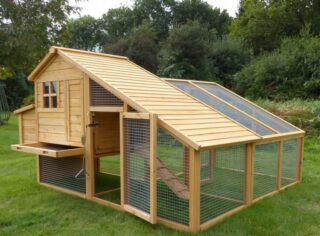
So that the maintenance of chickens does not become an unprofitable event, a special structure is being built for them.
The cost of an egg is made up largely of the price of laying hens, so keeping a bird only in the summer is unprofitable. If it is possible to appear on the site at least every other day, the chickens are left to winter and receive an egg for the entire next season.
Coop:
- restricts the freedom of movement of the bird on the site - laying takes place indoors, chickens do not peck plantings in the garden;
- provides protection against domestic and stray dogs, ferrets, weasels and birds of prey;
- preserves food from wild birds, reducing the likelihood of disease;
- protects the bird from bad weather, scorching sun, frost;
- prolongs the period of egg production in winter.
Based on the tasks, the chicken coop must be durable in order to limit the entry of foreign animals and maintain the necessary microclimate.
Types of chicken coops
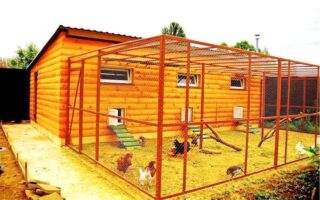
All types of poultry houses are classified according to several parameters:
- Operating times - summer, winter, all-season.
- By the method of content. Floor standing: on a litter and deep litter on top of an earth surface or concrete screed; on mesh or slatted floors with bedding or deep bedding. Cellular.
- By the nature of the building: temporary, portable, stationary.
It is recommended when building a chicken coop for 10 chickens with your own hands to immediately make a long-term structure, since temporary buildings are unsuitable for winter keeping.
Summer version is not insulated. The building may look like a fenced area with a small shed for birds to stay there at night. During the construction of a winter chicken coop, the walls are insulated with high quality. The promenade compartment is made small, open to the sun.
Rational use of space allows cellular maintenance. At the same time, they do not allocate a place for walking, and the cells themselves are installed in 2 tiers. Batteries with many rows are inconvenient to maintain.
The all-season poultry house has sufficient area for free movement of chickens in the air and at the same time is sufficiently insulated for winter keeping.
Walking, as a rule, is not equipped with a covering. Indoors, the floor can be earthen, concrete, wood. To insulate and facilitate cleaning, any kind of floor is covered with bedding in cool weather.
Portable structures are appropriate for large areas covered with grass. After all the vegetation has been eaten and the surface of the earth is covered with droppings, the chicken coop is moved to a new place.
What is taken into account in the project
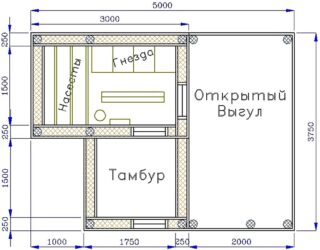
Before building a chicken coop for 10 chickens, they plan its location, choose a suitable layout for equipment, draw up a drawing for calculating materials.
Location requirements
When placing a poultry house on the site, they try to:
- create comfortable conditions for chickens;
- provide ease of maintenance;
- be sure to comply with sanitary standards.
If you place the chicken coop in a lowland, moisture will accumulate there, the bird will be uncomfortable, and access for maintenance will become more difficult. It is better to place the building on a slope or hill. On level areas, soil is added so that the floor of the walk and paddock is 15-20 cm above ground level.
If a dog is kept on the site, the chicken coop is located not far from the aviary. The neighborhood will greatly reduce the likelihood of attack by stray dogs and small predators. It is advisable to distinguish between the walking and the dog's enclosure with an opaque screen so that the bird is less nervous.
The sun's rays should illuminate the walking, this is important for the production of vitamins in the bird's body. At the same time, under the sun, the litter dries out faster and will require replacement after a longer time.
It is important to comply with the requirements of SNiP 30-02-97:
- from a residential building to a detached poultry house, at least 12 meters recede, and if the chicken coop and the house are built of combustible materials, then at least 15 m;
- the distance to the neighboring site cannot be less than 4 m, while the neighbors' residential building should also not be closer than 12 m;
- in the premises adjacent to the house for small livestock and poultry, a separate entrance is equipped, which should be located at least 7 m from the doors of the housing.
They choose a place from which the wind blows less often - this will save the owners from pungent odors, they must take into account the interests of neighbors.
Sizing and equipment required
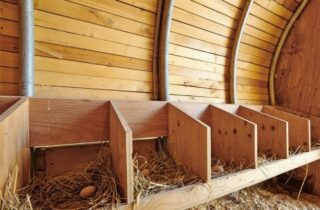
The size of the room depends on the weight and dimensions of the bird:
- when kept on the floor in a closed room, about 0.3 m of area should be accounted for for each laying hen;
- walking size - 0.5 m² / head;
- the floor area of the cage is calculated based on a maximum density of 0.1 m² / individual.
At smaller chickens, they become aggressive, begin to peck out a feather, diseases spread faster. Large parameters lead to unnecessary waste of building materials, difficulties with cleaning and increased litter consumption.
A chicken coop for ten heads is equipped as follows:
- Perches at the rate of 30 cm in length per bird, the distance from the wall to the crossbar is at least 270 mm, and 350 mm between the rows. The height of the first platform is 350 cm, the second from 700 mm. Perches are not made above each other, but displaced at a distance of at least 400 mm.
- Nests of standard size 300x300x400 mm, at the rate of 1 nest for 2-3 birds. When arranged in 2 rows, the height from the floor to the first level is 500 mm, to the second - 900 mm. In order not to enter the room for collecting eggs, the nests, if possible, are equipped with hatches on the side of the outer wall.
- Bathing baths measuring about 1m², into which coarse washed sand mixed with wood ash is poured.
- Feeders - periodic (for filling feed at one time) or bunker. A rotating bar is made over the container so that the chickens cannot sit over the feeder. Restrict access to feed to prevent birds from rowing the contents. The feeding front is 15–20 cm per head.
- Drinking bowls at the rate of 10-15 cm perimeter of the device for 1 chicken. Automatic drinkers save water as the bird cannot contaminate it. In the simplest case, any heavy container will do so that it cannot be turned over.
- Lighting. For a chicken coop for 10 chickens, a 30 W incandescent lamp or 5 W LED is enough.
- A hole measuring 30x25 cm. It helps to save heat, as the chickens get for walking through a small hole. At night, the manhole must be closed with a reliable lock.
- Exhaust ventilation that closes during cold weather.
To keep warm and collect waste, the floor is covered with a regular (up to 10 cm) or deep bedding of 15–20 cm.
The surface is covered with sand, seed husks, hay or straw chops. Sawdust is used with caution, as in the absence of food, chickens begin to peck up wood waste, which causes clogging of the crop and death of the laying hen.
Protection from predators
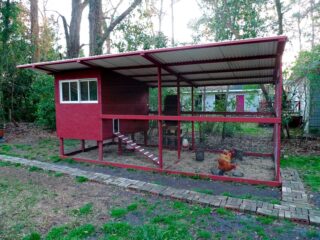
The main enemies of chickens in a country house located outside the village are predators of the weasel family: weasel, marten, ferret. They are found in almost all regions of the country.
In most cases, the attack takes place at night, therefore, special attention is paid to strengthening the walls, ceiling and door of the chicken coop, namely the room where the bird sleeps.
In order to prevent attacks:
- reliably seal all holes, cracks and cracks in walls, floors, floors;
- replace rotten boards;
- before arranging the floor, cover the surface with a netting with a mesh size of 40x40 mm;
- as an option, you can install a shed on piles;
- remove garbage, piles of boards and other building material from the territory, where a predator can find shelter;
- be sure to close the hole at night.
To protect against dogs, it is enough to fence the chicken coop and walk with a chain-link. It is important to dig in the canvas to a depth of 15–20 cm or lay a masonry net with a width of 40 cm or more around it. In this case, the animals will not be able to dig in.
Attacks of birds of prey are prevented by installing a roof over the walking area, it will also be a protection from precipitation.
How to build a chicken coop for 10 heads with your own hands
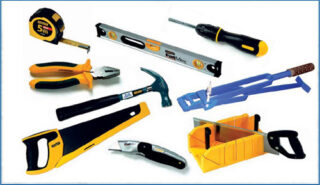
To build a poultry house, you will not need any unusual tools - everything you need is in the arsenal of a home master.
Depending on the selected materials, they prepare:
- grinder, drill, screwdriver, jigsaw;
- shovels - shovel and bayonet;
- measuring tool: tape measure, square, plumb line, level;
- hammer and sledgehammer;
- extension cord;
- containers for mixing concrete and mortar;
- trowel, trowel, grout.
From consumables you will need nails or screws.
Arrangement of the foundation
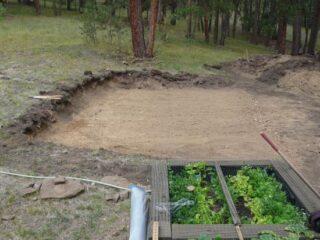
Brick chicken coops are equipped on a strip foundation. Serving as the basis for the walls, it excludes predators' digging.
The algorithm assumes the following actions:
- They clean the soil from vegetation residues and debris.
- Level the plot.
- Markup is carried out.
- A pit is being dug 30–40 cm deep and 5–10 cm wider than the expected thickness of the walls.
- Reinforcement is laid with a diameter of 10 mm.
- The formwork is installed 5-10 cm above the ground level.
- The foundation is poured with concrete of the M150 brand, observing the proportions of cement, sand and crushed stone - 1: 2.5: 3.5.
In hot weather, water the surface every 3-4 hours to prevent cracking.
The walls are laid in 10-15 days.
A monolithic foundation in the form of a slab is rarely poured. This design will require a large consumption of material, the floor turns out to be cold and dries out for a long time after changing the litter.
On heaving soils, they equip a columnar foundation with a grillage.
Walls

The walls are made of bricks, blocks.
Many information sources call the construction of walls from OSB panels a budget option. However, it is not. The slabs themselves cost from 200 r / m², external and internal sheathing, a layer of insulation (from 100 r / m²) and external decoration, without which the panel will become unusable after 2-3 years of operation, will be required. Thus, the profitability of using OSB lies only in the speed of construction of the building and savings on the foundation.
Walls made of boards will need to be sheathed with waterproofing and wind protection, since over time the boards dry out and cracks form.
The height of the walls is chosen from 2 m - periodically the chicken coop requires maintenance and it is more convenient to work without bending over.
In the thermal insulation of frame chicken coops, foam and extrusive polystyrene foam, mineral wool or foamed roll materials are used.
Roof
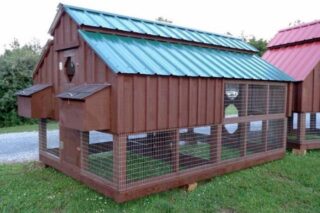
Any material is suitable for arranging the roof: slate, corrugated board, soft tiles and other roofing materials.
It is important to prevent gaps between the roof and walls for cold air to penetrate. In addition, small predators can easily climb up the walls and enter the room where the chickens spend the night.
Windows and doors
Windows must open, which is necessary to ventilate the premises. Single frames are insulated in winter with plastic foil or a second removable glazing is installed.
The opening window must be covered with a metal mosquito net that small predators cannot destroy.
Doors must be insulated.
Locks are installed on both sides so that the bird does not accidentally leave the chicken coop while feeding or cleaning.
Winter content
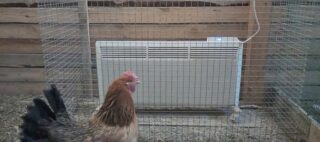
In order for the chickens to survive in winter conditions until the next season, it is enough to maintain the indoor temperature around 8-10 degrees.
You can save or minimize egg production by heating the chicken coop to an average daily temperature of about 15 ° C.
Daylight hours should not be shorter than 12 hours; artificial lighting is used to extend.
The hen house is heated with solid fuel stoves or electric heaters. With high-quality insulated walls, to maintain the desired microclimate in a chicken coop for 10 layers, it is enough to install a heater of 300-500 W. Additional heat is generated during the breathing of the bird and from the continuous deep litter, the calorific value of which can reach 50 W / m².








